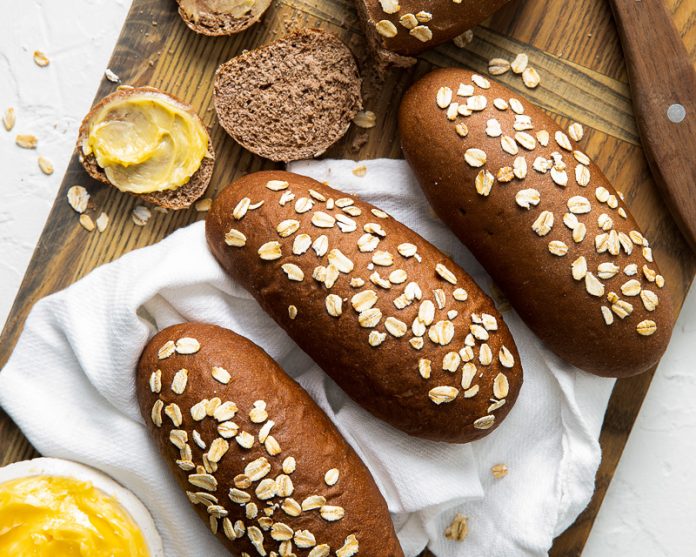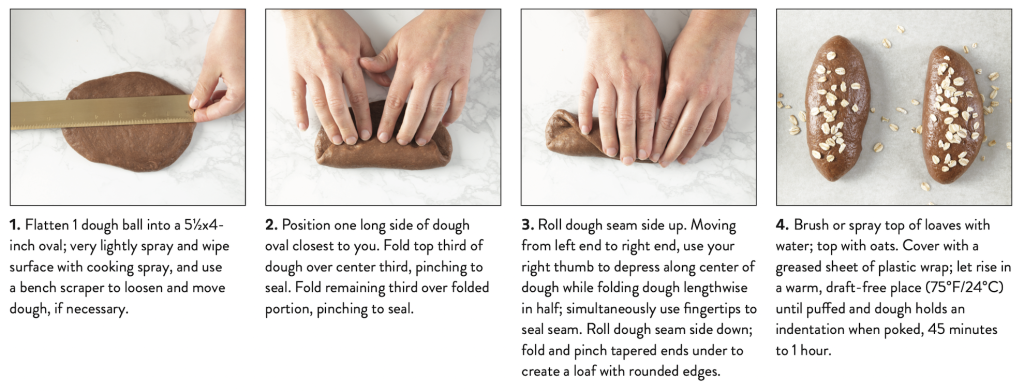
Inspired by the bread offering from a chain restaurant better known for its cheesecake, these perfectly portioned Honey-Molasses Brown Bread loaves take classic flavors to the comfort of your kitchen. Sweetened with a touch of honey and molasses, this mahogany-hued bread would be a wonderful addition to your favorite weeknight meal. With Platinum® Yeast from Red Star®, each loaf achieves the ultimate chewy yet tender texture with a hearty bite. A sprinkling of oats on top adds a note of toasted, slightly nutty flavor while also rounding out this loaves signature appearance. Served with a side of honey butter, it’ll be impossible to just have one.
Honey-Molasses Brown Bread
Makes 8 small loaves
Ingredients
- 2½ to 3 cups (318 to 382 grams) bread flour, divided
- 1½ cups (195 grams) whole wheat flour, divided
- ¼ cup (55 grams) firmly packed dark brown sugar
- 2 tablespoons (10 grams) Dutch process cocoa powder, sifted
- 1 tablespoon (9 grams) kosher salt
- 2¼ teaspoons (7 grams) instant yeast
- ¾ cup (180 grams) hot water (120°F/49°C to 130°F/54°C)
- ¼ cup (60 grams) hot whole milk (120°F/49°C to 130°F/54°C)
- ¼ cup (85 grams) clover honey
- 1 large egg (50 grams), room temperature
- 2 tablespoons (28 grams) vegetable oil
- 2 tablespoons (42 grams) molasses (not blackstrap)
- Old-fashioned oats, for sprinkling
- Honey butter, to serve
Instructions
- In the bowl of a stand mixer fitted with the paddle attachment, beat ½ cup (64 grams) bread flour, ½ cup (65 grams) whole wheat flour, brown sugar, cocoa, salt, and yeast at medium-low speed until combined. Add ¾ cup (180 grams) hot water and hot milk; beat until combined, about 1 minute, stopping to scrape sides of bowl. Add honey, egg, oil, and molasses; beat until combined, about 1 minute, stopping to scrape sides of bowl. With mixer on low speed, gradually add 2 cups (254 grams) bread flour and remaining 1 cup (130 grams) whole wheat flour, beating just until combined.
- Switch to the dough hook attachment. Beat at medium-low speed until a soft, slightly sticky dough forms, 6 to 10 minutes, stopping to scrape sides of bowl and dough hook; add up to remaining ½ cup (64 grams) bread flour, 1 tablespoon (8 grams) at a time, if dough is too sticky. (Dough will climb dough hook and mostly clear bowl but may still stick slightly to bottom and sides of bowl. Dough should pass the windowpane test; see Notes.) Turn out dough onto a clean surface, and gently shape into a ball.
- Spray a large bowl with cooking spray. Place dough in bowl, turning to grease top. Cover and let rise in a warm, draft-free place (75°F/24°C) until doubled in size, 2 to 2½ hours. (See Notes.)
- Line 2 rimmed baking sheets with parchment paper.
- On a clean surface, divide dough into 8 portions (about 130 grams each). Roll each portion into a ball; cover and let stand for 15 minutes. Flatten 1 dough ball into a 5½×4-inch oval; very lightly spray and wipe surface with cooking spray, and use a bench scraper to loosen and move dough, if necessary. Position one long side of dough oval closest to you. Fold top third of dough over center third, pinching to seal. Fold remaining third over folded portion, pinching to seal. Roll dough seam side up. Moving from left end to right end, use your right thumb to depress along center of dough while folding dough lengthwise in half; simultaneously use fingertips to seal seam. Roll dough seam side down; fold and pinch tapered ends under to create a 5×1½-inch loaf with rounded edges. Repeat with remaining dough. Place loaves 2½ to 3 inches apart on prepared pans. Brush or spray top of loaves with water; top with oats. Cover with a greased sheet of plastic wrap; let rise in a warm, draft-free place (75°F/24°C) until puffed and dough holds an indentation when poked, 45 minutes to 1 hour.
- Preheat oven to 350°F (180°C).
- Bake, one batch at a time, until loaves are a mahogany brown and an instant-read thermometer inserted in center registers 190°F (88°C), 12 to 16 minutes, rotating pan halfway through baking. Let cool on pans for 25 minutes before serving. Serve with honey butter.
Notes
Notes: To use the windowpane test to check dough for proper gluten development, lightly flour hands and pinch of (don’t tear) a small piece of dough. Slowly pull the dough out from the center. If the dough is ready, you will be able to stretch it until it’s thin and translucent like a windowpane. If the dough tears, it’s not quite ready. Beat for 1 minute, and test again.
This heartier dough typically requires a longer proofing time. For a slightly faster method, cover dough and let stand for just 30 minutes in step 3; then, divide, shape, proof, and bake as directed. Loaves may differ just slightly in appearance and flavor but will still be wonderfully delicious.
This heartier dough typically requires a longer proofing time. For a slightly faster method, cover dough and let stand for just 30 minutes in step 3; then, divide, shape, proof, and bake as directed. Loaves may differ just slightly in appearance and flavor but will still be wonderfully delicious.




